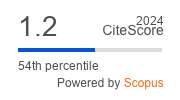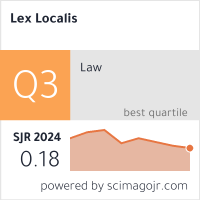Income Inequality Gap as a Indicator for Measuring the Effectiveness of Social Policy: A Case Study on the Czech Republic
DOI:
https://doi.org/10.4335/10.4335/20.2.347-367(2022)Keywords:
Czech Republic, income inequality gap, social income, social policyAbstract
Income inequality is a significant social problem that differentiates society according to the amount of income into structured groups, which do not always objectively correspond to the generally required national economic or political idea of income equality in society. The high level of income inequality, including its inappropriate structure, is a source of intergroup tension, hinders balanced economic development and limits the development of society as a whole with reference to social disadvantage and income stratification of society. The contribution aims to present social income as an indicator for moderating the income inequality in the society through which the subjects of social policy may influence the distribution of money income among the individual social groups within the society and thus improve the living standard of the population in the given country. The level of influence of income inequality through social income will be expressed by the so-called income inequality gap and will be assessed by means of changes in the index of income inequalities on the case of the Czech Republic.
References
Afonso, A., Schuknecht, L. & Tanzi, V. (2010) Income distribution determinants and public spending efficiency, The Journal of Economic Inequality, 8(3), pp. 367–389, https://doi.org/10.1007/s10888-010-9138-z.
Albertini, M. (2013) The relation between social class and economic inequality: A strengthening or weakening nexus? Evidence from the last three decades of inequality in Italy, Research in social stratification and mobility, 33(1), pp. 27-39, https://doi.org/10.1016/j.rssm.2013.05.001.
Alesina, A. & Perotti, R. (1996) Income distribution, political instability, and investment, European Economic Review, 40(6), pp. 1203–1228, http:// dx.doi.org/10.1016/0014-2921(95)00030-5.
Allmendinger, J. & Driesch E. (2014) Social inequalities in Europe: Facing the challenge. Discussion Paper P 2014-005 (Berlin: Social Science Center).
Atkinson, A. B. (1970) On the Measurement of Inequality, Journal of Economic Theory, 2(3), pp. 244–263, https://doi.org/10.1016/0022-0531(70)90039-6.
Bilancini, E. & Boncinelli, L. (2012) Redistribution and the notion of social status, Journal of public economics, 96(9-10), pp. 651-657, https://doi.org/10.1016/j.jpubeco.2012.05.007.
Brandolini, A. & Smeeding, T. M. (2008) Income inequality in richer and OECD countries, available at: http://www.fondazionebasso.it.site/_files/Scuola_per_la_buona_politica/2008/Materiali_laboratori/OECD%20Countries.PDF (December 16, 2020).
Corneo, G. & Gruner, H. P. (2000) Social limits to redistribution, American economic review, 90(5), pp. 1491-1507, https://doi 10.1257/aer.90.5.1491.
CSO. (2006-2016) Czech Statistical Office: Statistic - Household Income and Living Conditions, available at: https://www.czso.cz/csu/czso/household-income-and-living-conditions (December 10, 2020).
CSO. (2016) Czech Statistical Office: Revenue, expenditure and consumption of population, available at: https://www.czso.cz/documents/10180/23669467/000106c09.pdf/624879ec-e55 0 -4c38-92e8-571154df1ef1?version=1.0 (December 10, 2020).
Cvik, E. D. & MacGregor Pelikánová, R. (2016) Implementation of Directive 2014/17/EU and its Impact on EU and Member States Markets, from not only a Czech Perspective, Procedia – Social and Behavioral Sciences, 220(85), pp. 85-94, https://doi 10.1016/j.sbspro.2016.05.472.
Daly, M. & Wilson, M. (2000) Income Inequality and Homicide Rates in Canada and the United States, Canadian journal of criminology. Revue canadienne de criminology, 43(2), https://doi 10.3138/cjcrim.43.2.219.
Dorlach, T. & Savackan, O. (2018) The Political Economy of Economic and Social Policy in Contemporary Turkey: An Introduction to the Special Issue, Journal of Balkan and Near Eastern Studies, 20, pp. 311-317, https://doi.org/10.1080/19448953.2018.1385276.
Esping-Andersen, G. (1990) The Three Worlds of Welfare Capitalism (New Jersey: Princeton University Press).
Evropská komise. (2017) Odstraňování nerovností, available at: https://ec.europa.eu/info/sites/info/files/file_import/european-semester_thematic-factsheet_addressing-inequalities_cs.pdf (December 12, 2020).
Ferrari, L. (2018) Social limits to redistribution and conspicuous norms, Economics-the open access open-assessment e-journal, 12(57), pp. 1-21, http://dx.doi.org/10.5018/economics-ejournal.ja.2018-57.
Galbraith, J. K. (2009) Inequality, unemployment and growth: new measures for old controversies, Journal of Economic Inequality, 7(2), pp. 189-206, https://doi.org/10.1007/s10888-008-9083-2.
Gastwirth, J. L. (1971) A general definition of Lorenz curve, Econometrica, 39 (6), pp. 1037-1039.
Golany, B. & Thore, S. (1997) The Economic and Social Performance of Nations: Efficiency and Returns to Scale, Socio-Economic Planning Sciences, 31(3), pp. 191-204, https://doi.org/10.1016/S0038-0121(96)00032-8.
Graafland, J. & Lous, B. (2018) Economic freedom, income inequality and life satisfaction in OECD countries, Journal of happiness studies, 19(7), pp. 2071-2093, https://doi.org/10.1007/s10902-017-9905-7.
Grattan, P. et al. (2002) Age discrimination in public policy: a review of evidence (London: Help the aged).
Chang, H. (2011) 23 Things They Don´t Tell You About Capitalism (London: Penguin Books).
Chatterjee, A., Sinha, S. & Chakrabarti, B. K. (2007) Economic inequality: Is it natural?, Current Science, 92(10), pp. 1383-1389.
Cheung, F. (2018) Income redistribution predicts greater life satisfaction across individual, national and cultural characteristics, Journal of personality and social psychology, 115(5), pp. 867-882, https://doi.org/10.1037/pspp0000164.
International Labor Organization (2013) Perspectives on Labour Economics for Development, available at: https://www.ilo.org/global/publications/ilo-bookstore/order-online/books/ WCMS_190112/lang-en/index.htm (December 9, 2020).
Jánský P., Kalíšková, K. & Münich, D. (2016) Jak systém daní a sociálních dávek přispívá k nízké míře příjmové nerovnosti a relativní chudoby v České republice?, available at: http://home.cerge-ei.cz/munich/labor15/Resources/Other/Studie_IDEA_v6.pdf (December 14, 2020).
Jin, Y., Li, H. & Wu, B. (2011) Income inequality, consumption, and social-status seeking, Journal of Comparative Economics, 39(2), pp. 191-204, https://doi.org/10.2139/ssrn.1604047.
Kakwani, N. (1977). Application of Lorenz Curves in Economic Analysis, Econometrica, 45(3), pp. 719-727, https://doi.org/10.2307/1911684.
Kawachi, I., Kennedy, P. B., Lochner, K. & Prothrow-Stith, D. (1997) Social Capital, In-come Inequality and Mortality, American Journal of Public Health, 87(9), pp. 1491–1498, https://doi.org/10.2105/ajph.87.9.1491.
Keeley, B. (2015) Income inequality: The Gap between Rich and Poor, available at: http://espas.eu/orbis /sites/default/files/generated/document/en/0115391e.pdf, (December 14, 2020).
Khei‐Mie Wong, G. & Yu, L. (2002) Income and social inequality in China: impact on consumption and shopping patterns, International Journal of Social Economics, 29(5), pp. 370-384, https://doi.org/10.1108/03068290210423514.
King, W. I. (1912) The Elements of Statistical Method. (New York: Macmillan).
Kotlánová, E. & Turečková, K. (2016) Income Inequality in V4+ Countries at NUTS 2 Level, In: Conference Proceedings from 34nd International Conference Mathematical Methods in Economics (Liberec: TU), pp. 442-447.
Kotlánová, E. (2015) Income Inequality and Economic Growth, In: Proceedings of the 13th International Conference Economic Policy in the European Union Member Countries (Ostrava: VŠB-TU), pp. 288-294.
Kuo, Ch. T. & Chen, D. R. (2018) Double disadvantage: income inequality, spatial polarization and mortality rates in Taiwan, Journal of Public Health, 40(3), pp. 228–234, https://doi.org/10.1093/pubmed/fdx179.
Kuznets, I. (1955) Economic Growth and Income Inequality, The American Economic Review, 45(1), pp. 1–28.
Kvíčalová, J. (2014) Ekonomické faktory ovlivňující příjmovou nerovnost ve společnosti, In: Conference Proceedings of MEKON 2014 (Ostrava: VŠB-TU), pp. 60-70.
Lando, T. & Bertoli-Barsotti, L. (2016) Weak orderings for intersecting Lorenz curves, Metron, 74(2), pp. 177-192, https://doi.org/10.1007/s40300-016-0087-6.
Lapáček, M. (2007) Příjmová nerovnost a ekvivalenční stupnice, available at: http://nf.vse.cz/download/veda/workshops/inequality.pdf (December 18, 2020).
Li, H. & Zou, H. (1998) Income Inequality is not Harmful for Growth: Theory and Evidence, Review of Development Economics, 2(3), pp. 318-334, https://doi.org/10.1111/1467-9361.00045.
Litchfield, J. A. (1999) Inequality: Methods and Tools. Text for World Bank’s Web Site on Inequality, Poverty, and Socioeconomic Performance, available at: http://www.world bank.org/poverty/inequal/index.htm (December 1, 2020).
Lorenz, M. O. (1905) Methods of measuring the concentration of wealth, Publications of the American Statistical Association, 9(70), pp. 209-219, https://doi.org/10.2307/2276207.
Lundberg, O., Fritzell, J., Åberg Yngwe, M. & Kölegård, M. L. (2010) The potential power of social policy programmes: income redistribution, economic resources and health, International Journal of Social Wealth, 19(1), pp. 2-13, https://doi.org/10.1111/j.1468- 2397.2010.00727.x.
Malá, Z. & Červená, G. (2012) Dekompoziční analýza příjmové nerovnosti v České republice. Ekonomická revue, 15, pp. 5-14, doi:10.7327/cerei.2012.03.01.
Matlack, J. L. & Vigdor, J. L. (2008) Do rising tides lift all prices? Income inequality and housing affordability, Journal of Housing Economics, 17(3), pp. 212–24.
Noikokyrakis, G. & Sarafis P. (2018) Social protection and the challenges of the Europe-an Welfare State, Archives of Hellenis Medicine, 35(4), pp. 464-471.
Pascoal, R. & Rocha H. (2018) Inequality measures for wealth distribution: Population vs individuals’ perspective, Physica A-statistical mechanics and its applications, 492(1), pp. 1317-1326, https://doi.org/10.1016/j.physa.2017.11.059.
Pickett, K. E. & Wilkinson, R. G. (2015) Income inequality and health: a causal review, Social Science & Medicine, 128, pp. 316–326, https://doi: 10.1016/j.socscimed.2014.12.031.
Piotrowska, M. (2003) The redistributive role of fiscal policy in transition countries: the cases of Poland and the Czech Republic, In: VIII. Jornadas de economía internacional congreso (Castilla-La Man-cha: AEEFI).
Quattrociocchi, J. (2018) Group income and individual preferences for redistribution, Canadian journal of economics, 51(4), pp. 1386-1418, https://doi.org/10.1111/caje.12358.
Risso, A. W. & Sanchez Carrera, E. J. (2018) On the impact of innovation and inequality in economic growth, Economics of Innovation and New Technology, 28(1), pp. 64-81, https://doi.org/10.1080/10438599.2018.1429534.
Rowlingson, K. (2011) Does income inequality cause health and social problems?, available at: https://www.jrf.org.uk/sites/default/files/jrf/migrated/files/inequality-income-social-problems-full.pdf (October 20, 2021).
Sacchi, A. & Salotti, S. (2011) Income inequality, regional disparities, and fiscal decentralization in industrialized countries, available at: https://econpapers.repec.org/paper/rtrwpaper/0142.htm (October 20, 2021).
Shifa, M. & Leibbrandt, M. (2018) Relative economic position and subjective well-being in a poor society: Does relative position indicator matter?, Social indicators research, 139(2), pp. 611-630, https://doi.org/10.1007/s11205- 017-1739-5.
Schneider, D., Hastings, O. P. & LaBriola, J. (2018) Income inequality and class divides in parental investments, American sociological review, 83(3), pp. 475-507, https://doi.org/10.1177/0003122418772034.
Schraff, D. (2019) Regional redistribution and Eurosceptic voting, Journal of European public policy, 26(1), pp. 83-105, https://doi.org/10.1080/13501763.2017.1394901.
Schutz, R. (1951) On the Measurement of Income Inequality, The American Economic Review, 41(1), pp. 107–122.
Sirovátka, T. & Mareš, P. (2006) Poverty, social exclusion and social policy in the Czech Republic, Social policy and administration, 40(3), pp. 288-303, https://doi.org/10.1111/j.1467-9515.2006.00490.x.
Souza, P. H. G. F. (2018) A history of inequality: Top incomes in Brazil, 1926 – 2015, Research in social stratification and mobility, 57(1), pp. 35-45, https://doi.org/10.1016/j.rssm.2018.07.003.
Szczepaniak, M. (2020) Redistribution and the alleviation of income inequalities: the case of the European Union, Ekonomia i prawo – Economics and Law, 19(1), pp. 149-161, http://dx.doi.org/10.12775/EiP.2020.011.
Tiruneh, W. et al. (2009) Vývoj a perspektívy svetovej ekonomiky. Globálna finančná a hospodárska kríza (Bratislava: SAV).
Tröster, P., Koldinská, K. Hurka, P., Lang, R., Moravek, J., Pichrt, J., Štangova, V., Štefko, M., Tomeš, I., Vorišek, V & Vysokajova, M.(2018) Právo sociálního zabezpečení (Praha: C.H.Beck).
Turečková, K. (2007) Příjmové nerovnosti a jejich měření, Acta Academica Karviniensia, 1(1), pp. 191-198.
Turečková, K. (2015) Income Inequality by Method of Non-weighted Average Absolute Deviation: Case Study of Central & Eastern European Countries, Equilibrium, 10(4), pp. 99-110, https://doi.org/10.12775/EQUIL.2015.037.
Turečková, K. (2016) Method of non-weighted average absolute deviation in context of in-come inequality, case study of Czech Republic, In: Proceedings of the 20th International Conference Current Trends in Public Sector Research (Brno: MU Brno), pp. 201-206.
Turečková, K. (2018) Měření příjmové nerovnosti prostřednictvím metody směrodatné odchylky, available at: https://econpapers. repec.org/paper/opawpaper/0050.htm (October 20, 2021).
Uslaner, E. & Brown, M. (2002) Inequality, Trust, and Political Engagement, available at: https://www.researchgate.net/publication/242100160_Inequality_Trust_and_Political_Engagement (October 20, 2021).
Večerník, J. (2012) Subjektivní indikátory blahobytu: přístupy, měření, data, Politická ekonomie, 60(3), pp. 291-308, https://doi.org/10.18267/j.polek.843.








